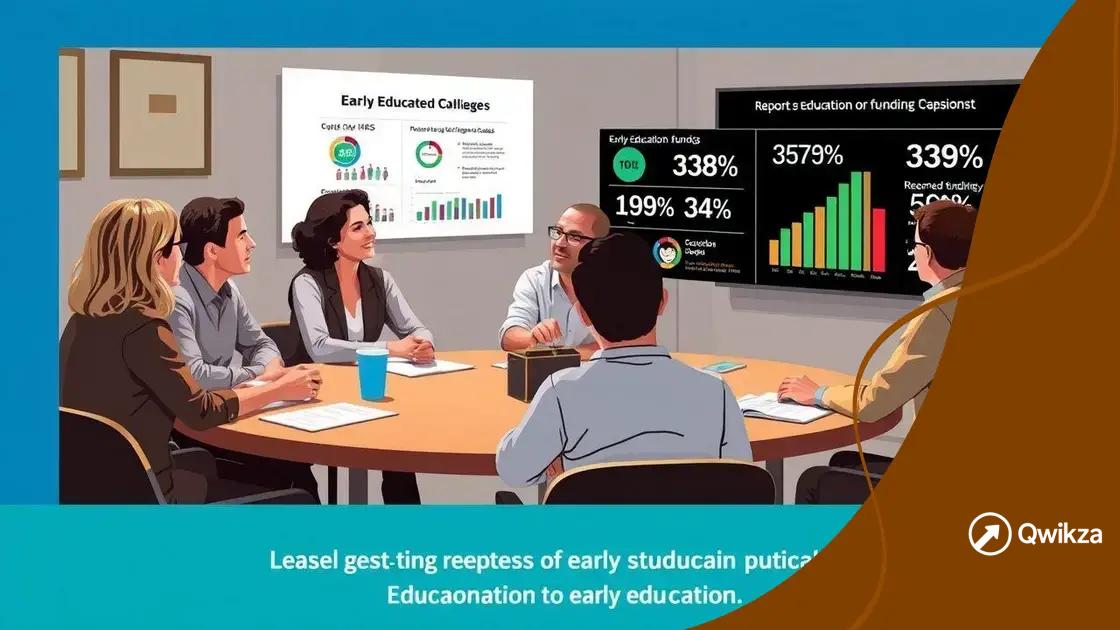Early education program funding status: what’s at stake?

The early education program funding status is vital for ensuring quality educational resources and development opportunities for children, as it significantly impacts their academic success and long-term societal benefits.
The early education program funding status is crucial for the development of young minds. Have you ever wondered how funding impacts local programs? Let’s dive into the current situation and what it means for communities.
Understanding early education funding
Understanding early education funding is essential for ensuring that children receive the best start in their learning journeys. Adequate funding enables schools and programs to provide impactful resources and services. When exploring the ins and outs of this funding, we can uncover its significance and the challenges that often accompany it.
The Importance of Funding
Early education funding plays a pivotal role in establishing quality educational experiences. With strong financial backing, programs can hire qualified educators and offer essential learning tools. Moreover, funding supports initiatives that promote inclusivity and access for all children.
- Enhanced teacher training and professional development.
- Access to modern educational materials and technology.
- Programs that cater to children with diverse needs.
In addition, funding helps maintain small class sizes, which are vital for personalized attention. This means each child can receive the support they need to thrive.
Challenges in Securing Funding
Despite the clear benefits, many early education programs face challenges in securing necessary funding. Budget constraints often limit what schools can provide.
- Competing priorities within government budgets.
- Economic downturns impacting available resources.
- Lack of awareness about the impact of early education.
As these challenges persist, advocates emphasize the need for sustained investments in early education funding. This will not only support existing programs but also ensure future generations can benefit fully from quality education.
Overall, understanding early education funding is crucial for parents, educators, and policymakers. By recognizing both its importance and the challenges faced, we can work towards better solutions that benefit children and communities.
Key statistics on funding effectiveness
Key statistics on funding effectiveness provide valuable insights into how financial resources impact early education programs. Understanding these statistics helps stakeholders recognize the benefits and areas for improvement in funding allocations.
Impact of Funding on Student Outcomes
Research shows a strong correlation between funding levels and student success. Programs with sufficient funding typically see improved outcomes, such as increased literacy rates and stronger social skills. Investment in early education not only enhances individual performance but also contributes to long-term societal benefits.
- Students in well-funded programs perform better academically.
- Higher funding leads to reduced dropout rates in later years.
- Quality early education reduces the need for remedial education.
Moreover, schools that prioritize funding for teacher training tend to have more engaged and effective educators, fostering a thriving learning environment. When teachers are well-supported, they can better cater to the needs of their students.
Financial Returns on Investment
Investing in early education yields considerable financial returns. Studies reveal that every dollar spent on early education can result in a return of up to $8 in future savings. This comes from decreased costs for social services, healthcare, and the criminal justice system. Clearly, funding early education leads to savings for society as a whole.
- Reduced costs for special education services.
- Lower crime rates associated with better early education.
- Long-term economic benefits from a more educated workforce.
The statistics highlight the critical need for ongoing support and investment in early education initiatives. By recognizing the effectiveness of funding, communities can advocate for policies that prioritize these vital programs.
Challenges faced in securing funding

Challenges faced in securing funding for early education programs are numerous and complex. Many factors contribute to the difficulties programs encounter when trying to obtain necessary financial support.
Budget Constraints
One of the biggest hurdles is budget constraints at both state and local levels. Government funding often competes with other pressing needs, such as healthcare and infrastructure. This can lead to early education programs receiving less support than they require.
- Limited funding resources hurt program development.
- Prioritization of other areas leads to cuts in education funding.
- Inconsistent funding affects program sustainability.
Moreover, during economic downturns, funding for education is one of the first areas to face cuts. This further exacerbates the struggle that early education programs face.
Lack of Awareness
Another challenge is the lack of awareness regarding the importance of early education funding. Many community members may not fully understand how essential these programs are for children’s development.
- Public perception often undervalues early education initiatives.
- Limited advocacy efforts for early education funding.
- Misconceptions about the effectiveness of early educational programs.
This lack of understanding makes it difficult to rally support and secure the funding needed. Advocates need to work hard to educate the public and policymakers on the positive impacts of early education.
Complex Application Processes
Additionally, the application processes for securing funding can be overwhelming. Many programs struggle with complicated grant applications that demand extensive documentation and detailed proposals.
- Complexity leads to frustration and abandoned applications.
- Time-consuming processes reduce program effectiveness.
- Lack of administrative support hampers funding efforts.
Overcoming these challenges is vital for the success of early education programs. Building a strong advocacy community and simplifying application processes can help secure the funding necessary for future growth.
Success stories from funded programs
Examining success stories from funded programs highlights the positive outcomes that can emerge when adequate resources are allocated to early education. These stories showcase how funding has transformed lives and enriched communities.
Case Study: Bright Futures Academy
One exemplary program is Bright Futures Academy, which received funding for expanding its curriculum. With this funding, the academy implemented a music and arts program that has greatly improved student engagement. Children who previously struggled in traditional settings thrived, showcasing increased creativity and teamwork skills.
- Students demonstrated a 30% increase in creativity assessments.
- Parents reported higher levels of student enthusiasm for learning.
- The program enhanced social interaction among children.
This success story exemplifies how targeted funding can lead to tangible benefits for students and families alike.
Innovative Early Learning Center
Another inspiring example comes from the Innovative Early Learning Center, which utilized its funding to focus on STEM education. This center integrated science, technology, engineering, and math into its daily activities. As a result, kids not only developed critical thinking skills but also sparked a long-term interest in these fields.
- Increase of 40% in students expressing interest in STEM careers.
- Enhanced problem-solving skills observed in children.
- Collaboration with local businesses for hands-on learning opportunities.
Programs like this demonstrate the importance of investing in comprehensive curricula that equip children for the future.
Community Impact
Beyond individual success stories, funded programs often have a significant impact on their communities. Schools that receive stable financial support contribute to lower crime rates and higher graduation rates in their areas.
- Community bonds strengthen as families engage with schools.
- Long-term economic benefits stem from educated citizens.
- Increased funding supports family workshops and resources.
These success stories from funded programs reveal the immense potential that lies in supporting early education. Through dedicated funding initiatives, we can continue to cultivate environments where children can flourish and communities can prosper.
Future outlook for early education funding
The future outlook for early education funding hinges on several critical factors that can influence how resources are allocated in upcoming years. Understanding these trends is vital for stakeholders who advocate for the importance of early education.
Growing Awareness
There is a growing awareness among policymakers and the public about the significance of early education. Research highlighting the long-term benefits of investing in young children is becoming more prominent. As more studies demonstrate the positive impacts of early education on academic success and social skills, funding is likely to receive greater attention.
- Increased public support for early education initiatives.
- More research funding for studies on early learning outcomes.
- Stronger advocacy groups pushing for policy changes.
This shift in awareness can drive more sustainable funding strategies, helping programs expand and improve.
Policy Changes and Government Initiatives
As discussions about education reform continue, many are calling for policies that prioritize early education. Several states have proposed increasing budgets specifically for early childhood education. By creating dedicated funds, states can ensure that essential programs have the resources they need to thrive.
- Potential for new legislation supporting early education.
- State-level initiatives to increase access and quality.
- Focus on equitable funding distribution across communities.
These policy changes reflect a proactive approach that can reshape the funding landscape for early education.
Collaboration and Community Involvement
Future funding may also rely on stronger collaboration between schools, local governments, and community organizations. Building partnerships can create a network of support that broadens funding sources. When communities come together to advocate for early education, they strengthen their chances of securing necessary funding.
- Shared resources lead to innovative funding solutions.
- Community awareness programs generate grassroots support.
- Partnerships with businesses can provide additional funding stream.
The collaboration between different stakeholders ultimately enhances the sustainability of funding for early education.
While challenges remain, the future outlook for early education funding is becoming more optimistic. Continued advocacy, informed policy-making, and community collaboration will play crucial roles in shaping the landscape of early childhood education.
FAQ – Frequently Asked Questions about Early Education Program Funding
Why is funding for early education important?
Funding for early education is crucial because it helps provide quality resources, skilled educators, and supportive learning environments that are essential for children’s development.
What challenges do early education programs face in securing funding?
Programs often face budget constraints, lack of public awareness about their importance, and complex application processes that can hinder their ability to secure necessary funds.
How can communities advocate for more funding?
Communities can advocate for funding by raising awareness about the benefits of early education and collaborating with local policymakers and organizations to promote supportive legislation.
What are the expected benefits of increased funding for early education?
Increased funding is expected to improve educational outcomes, reduce inequality, and enhance long-term societal benefits, such as lower crime rates and higher graduation levels.
